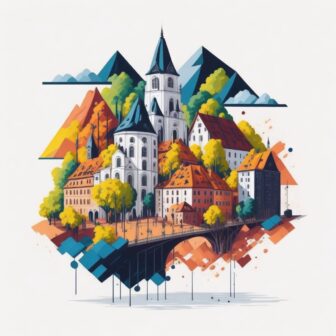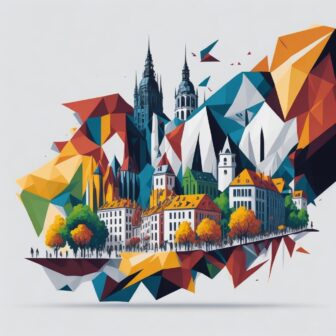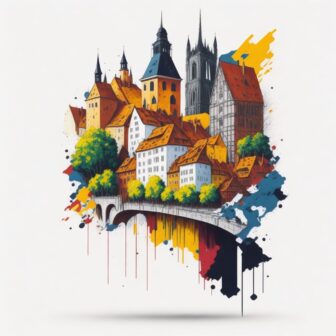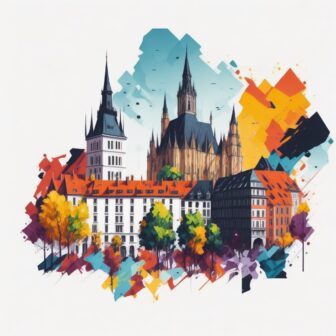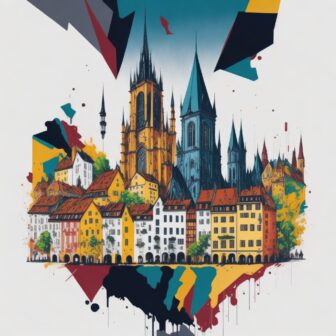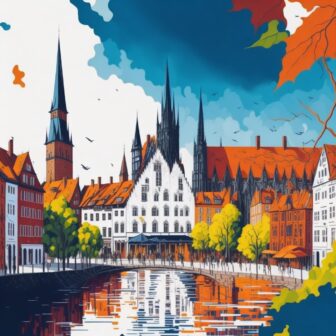20 Best Places to Visit in Bonn in 2023
Nestled on the banks of the picturesque Rhine River, Bonn beckons travelers with its remarkable array of best places to visit, landmarks, great attractions, and amazing sights. Welcome to Bonn, a city brimming with history, culture, and an enchanting blend of old-world charm and contemporary vibrancy.
As the birthplace of Ludwig van Beethoven and the former capital of West Germany, this captivating German city boasts a rich tapestry of architectural wonders, captivating museums, lush green spaces, and a delightful culinary scene. Prepare to embark on a journey through time as we explore the hidden gems and iconic treasures that make Bonn an irresistible destination for both history buffs and adventure seekers alike.
In a nutshell: Bonn Highlights
- Beethoven House: Immerse yourself in the life and legacy of the legendary composer, Ludwig van Beethoven, at the Beethoven House.
- Rhine Promenade: Take a leisurely stroll along the picturesque Rhine Promenade and soak in the breathtaking views of the river.
- Bonn Minster: Marvel at the architectural grandeur of Bonn Minster, a magnificent Romanesque cathedral that dates back to the 11th century.
- Poppelsdorf Palace: Step into the past with a visit to Poppelsdorf Palace, an elegant Baroque palace surrounded by lush gardens.
- Bundeskunsthalle: Delve into the world of art and culture at the Bundeskunsthalle, a renowned art museum and exhibition center.
1. Poppelsdorf Castle: A Remarkable Baroque Palace and Garden in Bonn
Poppelsdorf Castle, located in the district of the same name, is an exquisite baroque palace that stands as a beloved attraction in Bonn. Originally designed as a pleasure palace, Poppelsdorf Castle boasts an enchanting palace garden, creating a harmonious blend of architectural magnificence and natural beauty.
Connected to the stunning Electoral Palace by the picturesque Poppelsdorfer Allee, this castle forms a captivating line of sight, inviting visitors to explore its captivating grounds.
Today, Poppelsdorf Castle serves as a renowned venue for the ever-popular Poppelsdorf Castle Concerts, where music lovers gather to revel in the melodic performances held within its walls. But the castle holds more than just musical delights.
Venture inside, and you’ll discover the captivating Mineralogical Museum, showcasing a dazzling array of precious gems, minerals, and scientific wonders. It is also home to other esteemed scientific institutions, adding to the castle’s academic significance.
2. Electoral Palace and Court Garden: A Historic Landmark with a Modern Purpose
The Electoral Palace, a historic landmark in Bonn, now serves as the main building for the prestigious Friedrich Wilhelm University.
Since its inception in 1818, the castle has been an integral part of the university’s legacy, providing an awe-inspiring setting for learning and research.
With its origins dating back to the 16th century, the castle has undergone two reconstructions throughout the centuries while carefully preserving its original architectural style, ensuring a captivating glimpse into the past.
3. Bonn Minster: Where History and Faith Unite
The majestic Bonn Minster, situated on Münsterplatz, holds a significant place in Bonn’s history. Archaeological findings indicate the existence of a Roman memorial on the very site as early as the second century.
The church’s first construction took place around the middle of the sixth century, and since then, it has become the city’s main Catholic church. In 1956, Bonn Minster was honored with the title of Basilica Minor by the Vatican, a distinction that recognizes its historical significance and remarkable beauty.
4. Münsterplatz and Beethoven Monument: A Tribute to a Musical Genius
As you wander through Münsterplatz, your eyes will be drawn to a magnificent monument paying homage to the renowned composer Ludwig van Beethoven. Unveiled in 1845 during a joyous celebration of Beethoven’s 75th birthday, this statue stands proudly in front of the old post office.
Intricately designed, the monument incorporates representations of Beethoven’s iconic compositions, serving as a visual testament to his extraordinary musical legacy. Fondly nicknamed the “postmaster” by locals due to its location, the Beethoven monument has become a beloved photo spot for visitors.
5. Name of Jesus Church: A Post-Gothic Gem in the Heart of Bonn
Situated in the vibrant center of Bonn, the Name of Jesus Church stands as a remarkable post-Gothic masterpiece. This Catholic church owes its construction and name to a fascinating discovery—a piece of wood bearing the sacred name of Jesus.
Today, the church has been recognized as a listed building and warmly welcomes visitors to explore its spiritual and architectural splendor.
Step inside the Name of Jesus Church and be transported to a realm of tranquility and awe-inspiring beauty. Marvel at the intricate details of its design, showcasing the craftsmanship of bygone eras. As you wander through the sacred space, feel a sense of serenity envelop you, offering a place for contemplation and reflection.
6. Chancellor’s Bungalow: Where History and Culture Unite
The Chancellor’s Bungalow, once the residence and workplace of the German Chancellor until the government’s relocation to Berlin, now serves a different purpose.
Nestled in a picturesque park between the former chancellery and the Palais Schaumburg, this stately house has been transformed into a captivating museum. Step inside and discover a treasure trove of historical artifacts and exhibits that shed light on the life and times of Germany’s political leaders.
Beyond its role as a museum, the Chancellor’s Bungalow has become a versatile venue for concerts and readings, adding a touch of cultural vibrancy to its distinguished presence.
Since 2001, this remarkable building has proudly held the status of a listed building, recognizing its architectural significance and preserving its legacy for generations to come.
7. Federal Building: Witness to Political History
The Bundeshaus in Bonn carries a significant legacy as the former venue for the sessions of the German Bundestag from 1949 to 1999, before the government’s relocation to Berlin.
Today, this iconic building has been repurposed into a thriving conference center and is an integral part of the UN campus.
While the political debates have shifted to a new capital, the Federal Building stands as a testament to Germany’s democratic journey. Its halls echo with the voices of past leaders and the decisions that shaped the nation.
Explore its grandeur, appreciate its architectural splendor, and gain a deeper understanding of the country’s political evolution.
8. Palais Schaumburg: A Stately Residence and Symbol of Political Power
In the heart of Bonn, the Palais Schaumburg stands as a remarkable testament to Germany’s political history. From 1949 to 1976, this grand castle-like building served as the first official residence of the Federal Chancellor.
Since the government’s relocation to Berlin, it has assumed the role of the Chancellery’s second office and continues to hold significance as an emblem of political power.
Originally constructed in the 19th century as a city villa, the Palais Schaumburg underwent expansions around the turn of the century, transforming it into the palace we see today.
Stepping inside, visitors can explore various sections of the palais, including the Chancellor’s former study and the former cabinet room, offering a glimpse into the inner workings of German governance.
Palais Schaumburg in Bonn is not only a historic landmark but also a living testament to the political evolution of the country, inviting visitors to reflect on the past while appreciating its architectural splendor.
9. House of History: Unveiling the Stories of Post-War Germany
The House of History stands as a captivating museum dedicated to German history after World War II. Located on the museum mile, this exhibition building houses a diverse range of permanent exhibitions, offering insights into pivotal moments of the nation’s past.
Among the featured exhibits is a thought-provoking display on the end of the war and the era of a divided Germany.
In addition to its permanent displays, the House of History hosts regularly changing and traveling exhibitions that shed light on current topics, creating a dynamic and engaging experience for visitors.
Step into this immersive museum and embark on a journey through time, exploring the intricacies of Germany’s historical narrative.
10. Botanical Gardens: Nature’s Oasis in the City
The botanical garden of Friedrich-Wilhelms-University Bonn is not only a haven of natural beauty but also an educational space.
Spread over approximately twelve hectares, this stunning garden cultivates around 11,000 different plant species. These plants serve as both teaching materials for the university and a captivating exhibition for visitors to admire.
Tracing its roots back to the 16th century, the garden underwent transformation in the early 19th century when it became part of the university’s property. Today, it stands as a testament to the university’s commitment to botanical education and research.
Among its attractions, visitors will discover Germany’s largest collection of carnivorous plants, a unique highlight that adds to the garden’s allure.
RELATED:
Famous Landmarks in Germany You Must Visit
Best Cities to Visit in Germany
5 Days in Germany The Perfect Itinerary
11. Beethoven-Haus: A Shrine to the Maestro’s Legacy
Bonngasse is home to the Beethoven-Haus, the birthplace of the legendary composer Ludwig van Beethoven. This historic building has been lovingly transformed into a memorial, museum, and cultural institute, preserving the maestro’s heritage for generations to come.
Saved from demolition by a dedicated association in the 19th century, the Beethoven-Haus is not only a museum but also houses an archive, library, and a chamber music hall.
The permanent exhibition delves into the life and works of Beethoven, allowing visitors to immerse themselves in his musical genius. Additionally, the Beethoven-Haus hosts temporary special exhibitions, exploring related topics and individuals connected to Beethoven’s legacy.
A visit to the Beethoven-Haus is a must for music enthusiasts and those seeking a deeper understanding of the profound impact Beethoven had on the world of classical music.
12. Schloss Drachenburg: A Majestic Castle with a Fascinating History
Located just a short distance from Bonn and offering a stunning view visible from the city, stands the enchanting Drachenburg Castle. Perched atop the Drachenfels, a picturesque hill in the outskirts of Bonn, this magnificent castle is recognized as a listed building, showcasing its architectural and historical significance.
Today, the castle houses a museum that delves into the history of nature conservation in Germany, providing visitors with a unique perspective on the country’s efforts to protect its natural treasures. After a tumultuous past, Drachenburg Castle now welcomes guests, inviting them to explore its grand halls and immerse themselves in its rich heritage.
The castle’s striking backdrop has also caught the attention of the film and television industry, making it a popular location for various productions.
13. Kennedy Bridge: Connecting Bonn’s Heart
Spanning the Rhine River, the Kennedy Bridge takes its place as the middle of the three Bonn Rhine bridges, connecting the city center with the vibrant district of Beuel. Built in 1949 on the pillars of the Old Rhine Bridge, this bridge holds a significant historical connection.
Following the tragic assassination of President John F. Kennedy, it was aptly renamed the Kennedy Bridge on December 2, 1963.
One notable feature of the bridge is its iconic figure, which was originally attached to the Old Rhine Bridge and retained during the rebuilding process.
This figure, known for its distinctive gesture, cheekily stretches its buttocks towards the Beuel side of the bridge. It serves as a playful dig at the Beuelers, who were reluctant to contribute to the costs of the Old Rhine Bridge. The Kennedy Bridge stands as both a vital transportation link and a symbol of historical remembrance.
14. Kreuzbergkirche: A Place of Serenity and Scenic Beauty
Nestled in the district of Endenich, the Kreuzbergkirche has a storied history dating back to 1627. Built on the site of a former place of pilgrimage, the church draws visitors with its captivating baroque architecture.
Before the church’s construction, a cross chapel and a nearby cross lent their names to the mountain, creating the origin of its unique appellation.
To this day, the Kreuzbergkirche remains a beloved destination, offering visitors not only a place of worship but also a breathtaking view of Bonn and its surrounding areas.
From the church’s vantage point, one can marvel at the city’s beauty while enjoying a sense of tranquility and spiritual contemplation.
15. Old Town Hall: A Timeless Symbol of Bonn’s Heritage
Dominating Bonn’s market square, the Old Town Hall is an architectural gem that exudes the elegance of Rococo design. Erected in the 18th century, this three-storey building served as the administrative hub of the city.
While it no longer functions as the seat of the city administration, it continues to play a role in representing Bonn’s rich history and cultural heritage.
During Bonn’s tenure as the capital, the Old Town Hall played a pivotal role in hosting state visits and important events. Today, it stands as a reminder of the city’s prestigious past and serves as a testament to its enduring charm.
As you wander through the square, allow the Old Town Hall to transport you to a bygone era, where the echoes of Bonn’s illustrious history still resonate.
16. Old Customs: A Window to Bonn’s Rich History
Situated in the heart of Bonn, the Old Customs building stands as a testament to the city’s historical fortifications.
Once a bastion of Bonn’s city walls, this historic structure now holds the status of a listed building, preserving its architectural significance. Perched on the university grounds, the Old Customs offers a breathtaking view of the Rhine River and the majestic Siebengebirge mountain range.
Delving into its past, the building served as an air raid shelter during World War II, and the tunnels within provide a glimpse into that era. Explore the Old Customs and immerse yourself in the stories etched within its walls.
17. St. Remius: A Gothic Gem in Bonn’s Old Town
Nestled in the heart of Bonn’s old town, St. Remius is a Roman Catholic church known for its distinctive feature—the absence of a steeple.
This Gothic-style church, initially built by a Franciscan order in the 14th century, has undergone several reconstructions and renovations throughout its long history.
With more than 700 years of existence, St. Remigius has been recognized as a listed building, allowing visitors to marvel at its architectural beauty both during services and outside of them.
Step inside this ancient sanctuary and be transported to a realm of tranquility and reverence.
18. Double Church of St. Maria and St. Clemens: A Romanesque Masterpiece
Located in the Schwarzrheindorf district, the Double Church of St. Maria and St. Clemens stands as one of Germany’s most significant Romanesque churches.
This historic architectural gem is renowned for its remarkable ceiling paintings that have garnered widespread acclaim. As a listed building, the church showcases the fusion of artistic mastery and religious devotion.
Make sure to admire the Christmas crib created by the celebrated Munich crib maker, Sebastian Osterrieder, in 1926. The Double Church of St. Maria and St. Clemens invites you to witness the magnificence of its Romanesque grandeur.
19. Japanese Garden: A Serene Oasis in Rheinaue Park
The Japanese Garden, created for the Federal Horticultural Show in 1979, is a captivating sanctuary nestled within Bonn’s Rheinaue Park.
Immerse yourself in the tranquil ambiance as you encounter a sprawling lake adorned with an island, a picturesque hill, a soothing waterfall, and a mesmerizing 13-tiered stone pagoda.
This garden harmoniously combines various styles of Japanese horticulture, offering visitors the opportunity to explore a meditation garden and a tea garden.
To fully appreciate its beauty, take a leisurely stroll through the Japanese Garden, following the recommended anticlockwise path.
20. Cherry Blossom Road: A Floral Extravaganza
While not the sole cherry blossom road in Germany, Bonn’s Heerstraße is undoubtedly the most renowned.
Each spring, this enchanting street transforms into a magnificent sea of delicate pink cherry blossoms, attracting visitors from near and far in search of the perfect photograph.
The Japanese cherry trees were carefully planted along Bonn’s narrower streets, providing a delightful spectacle while maintaining the brightness of the surrounding apartments.
From April to May, Bonn’s cherry blossoms paint not only Heerstraße but also many other streets in the old town with a unique and mesmerizing floral display.
Bonn is a treasure trove of best places to visit, iconic landmarks, captivating attractions, and awe-inspiring sights. From the grandeur of Poppelsdorf Castle to the historical charm of St. Remius and the cultural significance of Beethoven-Haus, this city embraces its rich heritage while offering a vibrant and modern experience. Bonn beckons travelers with its unique blend of history, nature, and cultural delights, promising an unforgettable journey through its captivating streets and cherished landmarks.

